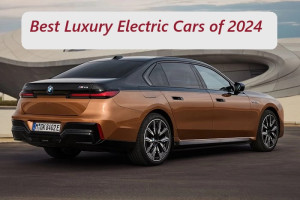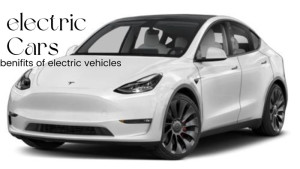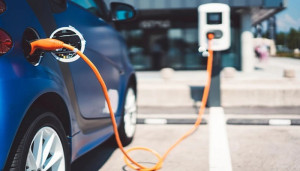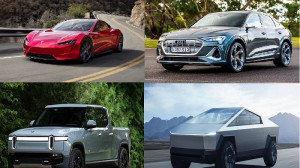The Latest Electric Car Technology: What You Need to Know
Learn about innovative safety features such as lower center of gravity, Advanced Driver Assistance Systems (ADAS), and cybersecurity measures, elevating safety standards in electric vehicles.

The Latest Electric Car Technology: What You Need to Know
The popularity of electric cars is at the top, and there are a few critical reasons for this. First, more people are becoming aware of and concerned about the environment and climate change. People want to use cars that are better for the planet. Second, the cost of fuel is going up, and people want to be less dependent on traditional fuels. They are looking for ways to be more independent when it comes to energy.
Third, the government is supporting the use of electric cars by giving incentives and subsidies. This makes it easier for people to buy electric vehicles. Also, there have been improvements in the technology of batteries used in electric cars. The batteries are getting better, and there is a growing infrastructure for charging these cars. This means that electric vehicles are becoming more convenient and practical for everyday use.
Also Read: Best electric luxury cars for 2023
What types of advanced technologies are integrated into electric vehicles to enhance both the convenience and luxury of your lifestyle?
Advanced battery technology:
You may have heard that the most essential part of an electric automobile is the battery. The battery usually powers the electric motors that drive the wheels of the car. Thus, it should come as no surprise that businesses and researchers are making significant investments in battery technology. The following are some fascinating advancements in battery technology:
- Sodium-Ion Batteries: These batteries are starting to show promise as a lithium-ion battery substitute. Because it is inexpensive and widely available, sodium is a desirable material for batteries. Compared to lithium-ion batteries, sodium-ion batteries are more stable and less prone to overheating. Still, they have a little lower energy density. The potential of these new batteries is quite intriguing. As manufacturers and academics work to refine these battery technologies, we should expect to see improved performance, reduced costs, and higher efficiency from electric vehicles.
- Solid-State Batteries: Unlike traditional lithium-ion batteries, which employ a liquid electrolyte, solid-state batteries use a solid electrolyte. It is anticipated that solid-state batteries will last longer, have a higher energy density, and charge more quickly.
- Lithium-air batteries: Compared to lithium-ion batteries, lithium-air batteries can store ten times more energy. Although lithium-air batteries are still in the research and development stage, laboratory testing has produced encouraging results.
- Fire-Resistant Battery Casing: Manufacturers are developing new heat-resistant materials and fire suppression systems to further minimize the risk of battery fires, even in severe accidents.
- Battery Monitoring and Diagnostics: Advanced real-time monitoring systems can detect any potential issues within the battery cells before they escalate, allowing for preventive measures and early warnings.

Improves charging infrastructure:
The infrastructure for charging electric cars is one of the main challenges that consumers have when contemplating an acquisition. It used to be difficult to charge an electric automobile because there were few charging stations on the road, and the charging durations were lengthy. Nonetheless, businesses are working hard these days to resolve these problems. Here are a few of the most recent developments in infrastructure for charging:
- Ultra-fast charging: More and more manufacturers are producing electric vehicles with 350 kW of power available for charging. Ultra-fast charging stations are also becoming increasingly common. This indicates that it takes less than 30 minutes to charge an electric vehicle from empty to 80% fully.
- Wireless Charging: Electric vehicles may now be charged wirelessly, thanks to technology! Just picture being able to park your car and have wireless charging begin to happen on its own. No more leaving cables plugged in and unplugged.
- Portable Chargers: With the growing popularity of portable charging stations, drivers can charge their electric cars wherever they go without worrying about running out of charging stations. The general public will undoubtedly find electric automobiles more convenient and accessible thanks to the developments achieved in the infrastructure for charging them. Long charge times and range concerns are gradually disappearing from the world.
- Predictive charging: Systems can learn your driving patterns and pre-condition the battery at a scheduled charging station, optimizing charging speed and saving time.
Advances and innovative Safety features:
Electric vehicles (EVs) incorporate cutting-edge safety technologies that distinguish them from conventional automobiles.
- Lower centre of gravity: One key advantage is their lower centre of gravity, reducing the risk of rollovers in the event of an accident. This feature enhances overall stability and contributes to a safer driving experience.
- ADAS: Moreover, specific EV models are equipped with sophisticated Advanced Driver Assistance Systems (ADAS), elevating safety standards to new heights. These systems include Lane Departure Warning, which alerts the driver if the vehicle unintentionally drifts out of its lane;
- Blind-Spot Detection: Blind spot monitoring offers a vigilant eye on areas not easily visible to the driver. Adaptive Cruise Control ensures a dynamic and responsive driving experience by automatically adjusting the vehicle's speed based on the surrounding traffic.
- Cybersecurity Enhancements: As EVs become more connected, manufacturers are developing advanced cybersecurity measures to protect against hacking and manipulation of onboard systems.
- Emergency Call Automation: Systems that automatically call emergency services in case of accidents are being developed, ensuring prompt response and potentially saving lives.
- Level 2+ Autonomy: We're seeing more EVs capable of hands-free driving in specific situations, like highway cruising. These systems rely on advanced radars, cameras, and LiDAR to maintain safe distances and control steering within lane markings.
- Traffic Sign Recognition and Adaptation: New systems can read traffic signs and automatically adjust speed, lane changes, and other vehicle behaviour to comply with regulations.
- Next-Generation Collision Avoidance: More precise sensor fusion and software improvements are leading to quicker and more accurate detection of pedestrians, cyclists, and other potential hazards, with faster braking and swerving manoeuvres to avoid collisions.
- Fatigue detection: Cameras monitor driver behaviour, detecting drowsiness or distraction and issuing warnings to ensure safe driving.
- V2X (vehicle-to-everything) communication: Vehicles can communicate with other vehicles and infrastructure, providing real-time traffic updates and warnings about hazards.

It's important to note that new safety features may not be available on all EVs or at the same time. Always research the specific safety features offered by the
models you're considering and familiarize yourself with how they work before
relying on them.
Smooth Driving:
Because internal combustion engines are absent from EVs, they ride quietly and more smoothly. Additionally, because electric motors offer rapid torque, drivers and passengers may accelerate more quickly and have a more pleasant ride. Because of the low centre of gravity, the comfortable ride also allows for improved handling, especially on slick terrain or over sharp curves. Infotainment systems are getting more thoughtful about EV needs. They can factor in current battery levels, charging stations along the way, and real-time energy consumption to plan the most efficient route, reducing range anxiety.
Convenient charging:
Charging an electric vehicle (EV) has become a convenient process, thanks to the accompanying charging accessories. Whether at home or on the go, EV owners can effortlessly charge their vehicles using various options. These include a standard power outlet at home, a dedicated level 2 home charging station, or public charging stations. Typically, EVs are equipped with a standard charging cord that can be plugged into any compatible outlet, streamlining the charging experience. Moreover, continuous innovations in charging accessories have led to improved efficiency and reduced charging times, offering users the advantage of a faster and more seamless charging process. As the EV infrastructure continues to evolve, the accessibility and ease of charging further contribute to the growing appeal of electric vehicles.

The Latest Electric Car Technology: What You Need to Know
The popularity of electric cars is at the top, and there are a few critical reasons for this. First, more people are becoming aware of and concerned about the environment and climate change. People want to use cars that are better for the planet. Second, the cost of fuel is going up, and people want to be less dependent on traditional fuels. They are looking for ways to be more independent when it comes to energy.
Third, the government is supporting the use of electric cars by giving incentives and subsidies. This makes it easier for people to buy electric vehicles. Also, there have been improvements in the technology of batteries used in electric cars. The batteries are getting better, and there is a growing infrastructure for charging these cars. This means that electric vehicles are becoming more convenient and practical for everyday use.
Also Read: Best electric luxury cars for 2023
What types of advanced technologies are integrated into electric vehicles to enhance both the convenience and luxury of your lifestyle?
Advanced battery technology:
You may have heard that the most essential part of an electric automobile is the battery. The battery usually powers the electric motors that drive the wheels of the car. Thus, it should come as no surprise that businesses and researchers are making significant investments in battery technology. The following are some fascinating advancements in battery technology:
- Sodium-Ion Batteries: These batteries are starting to show promise as a lithium-ion battery substitute. Because it is inexpensive and widely available, sodium is a desirable material for batteries. Compared to lithium-ion batteries, sodium-ion batteries are more stable and less prone to overheating. Still, they have a little lower energy density. The potential of these new batteries is quite intriguing. As manufacturers and academics work to refine these battery technologies, we should expect to see improved performance, reduced costs, and higher efficiency from electric vehicles.
- Solid-State Batteries: Unlike traditional lithium-ion batteries, which employ a liquid electrolyte, solid-state batteries use a solid electrolyte. It is anticipated that solid-state batteries will last longer, have a higher energy density, and charge more quickly.
- Lithium-air batteries: Compared to lithium-ion batteries, lithium-air batteries can store ten times more energy. Although lithium-air batteries are still in the research and development stage, laboratory testing has produced encouraging results.
- Fire-Resistant Battery Casing: Manufacturers are developing new heat-resistant materials and fire suppression systems to further minimize the risk of battery fires, even in severe accidents.
- Battery Monitoring and Diagnostics: Advanced real-time monitoring systems can detect any potential issues within the battery cells before they escalate, allowing for preventive measures and early warnings.

Improves charging infrastructure:
The infrastructure for charging electric cars is one of the main challenges that consumers have when contemplating an acquisition. It used to be difficult to charge an electric automobile because there were few charging stations on the road, and the charging durations were lengthy. Nonetheless, businesses are working hard these days to resolve these problems. Here are a few of the most recent developments in infrastructure for charging:
- Ultra-fast charging: More and more manufacturers are producing electric vehicles with 350 kW of power available for charging. Ultra-fast charging stations are also becoming increasingly common. This indicates that it takes less than 30 minutes to charge an electric vehicle from empty to 80% fully.
- Wireless Charging: Electric vehicles may now be charged wirelessly, thanks to technology! Just picture being able to park your car and have wireless charging begin to happen on its own. No more leaving cables plugged in and unplugged.
- Portable Chargers: With the growing popularity of portable charging stations, drivers can charge their electric cars wherever they go without worrying about running out of charging stations. The general public will undoubtedly find electric automobiles more convenient and accessible thanks to the developments achieved in the infrastructure for charging them. Long charge times and range concerns are gradually disappearing from the world.
- Predictive charging: Systems can learn your driving patterns and pre-condition the battery at a scheduled charging station, optimizing charging speed and saving time.
Advances and innovative Safety features:
Electric vehicles (EVs) incorporate cutting-edge safety technologies that distinguish them from conventional automobiles.
- Lower centre of gravity: One key advantage is their lower centre of gravity, reducing the risk of rollovers in the event of an accident. This feature enhances overall stability and contributes to a safer driving experience.
- ADAS: Moreover, specific EV models are equipped with sophisticated Advanced Driver Assistance Systems (ADAS), elevating safety standards to new heights. These systems include Lane Departure Warning, which alerts the driver if the vehicle unintentionally drifts out of its lane;
- Blind-Spot Detection: Blind spot monitoring offers a vigilant eye on areas not easily visible to the driver. Adaptive Cruise Control ensures a dynamic and responsive driving experience by automatically adjusting the vehicle's speed based on the surrounding traffic.
- Cybersecurity Enhancements: As EVs become more connected, manufacturers are developing advanced cybersecurity measures to protect against hacking and manipulation of onboard systems.
- Emergency Call Automation: Systems that automatically call emergency services in case of accidents are being developed, ensuring prompt response and potentially saving lives.
- Level 2+ Autonomy: We're seeing more EVs capable of hands-free driving in specific situations, like highway cruising. These systems rely on advanced radars, cameras, and LiDAR to maintain safe distances and control steering within lane markings.
- Traffic Sign Recognition and Adaptation: New systems can read traffic signs and automatically adjust speed, lane changes, and other vehicle behaviour to comply with regulations.
- Next-Generation Collision Avoidance: More precise sensor fusion and software improvements are leading to quicker and more accurate detection of pedestrians, cyclists, and other potential hazards, with faster braking and swerving manoeuvres to avoid collisions.
- Fatigue detection: Cameras monitor driver behaviour, detecting drowsiness or distraction and issuing warnings to ensure safe driving.
- V2X (vehicle-to-everything) communication: Vehicles can communicate with other vehicles and infrastructure, providing real-time traffic updates and warnings about hazards.

It's important to note that new safety features may not be available on all EVs or at the same time. Always research the specific safety features offered by the
models you're considering and familiarize yourself with how they work before
relying on them.
Smooth Driving:
Because internal combustion engines are absent from EVs, they ride quietly and more smoothly. Additionally, because electric motors offer rapid torque, drivers and passengers may accelerate more quickly and have a more pleasant ride. Because of the low centre of gravity, the comfortable ride also allows for improved handling, especially on slick terrain or over sharp curves. Infotainment systems are getting more thoughtful about EV needs. They can factor in current battery levels, charging stations along the way, and real-time energy consumption to plan the most efficient route, reducing range anxiety.
Convenient charging:
Charging an electric vehicle (EV) has become a convenient process, thanks to the accompanying charging accessories. Whether at home or on the go, EV owners can effortlessly charge their vehicles using various options. These include a standard power outlet at home, a dedicated level 2 home charging station, or public charging stations. Typically, EVs are equipped with a standard charging cord that can be plugged into any compatible outlet, streamlining the charging experience. Moreover, continuous innovations in charging accessories have led to improved efficiency and reduced charging times, offering users the advantage of a faster and more seamless charging process. As the EV infrastructure continues to evolve, the accessibility and ease of charging further contribute to the growing appeal of electric vehicles.













